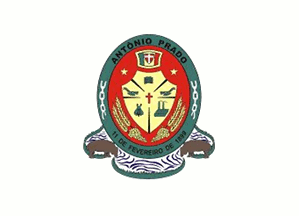 image by Dirk Schönberger,
26 December 2011
image by Dirk Schönberger,
26 December 2011
Source: http://cid-57cc02038c003794.office.live.com/self.aspx/.Documents

Last modified: 2012-02-11 by ian macdonald
Keywords: rio grande do sul | antônio prado |
Links: FOTW homepage |
search |
disclaimer and copyright |
write us |
mirrors
 image by Dirk Schönberger,
26 December 2011
image by Dirk Schönberger,
26 December 2011
Source:
http://cid-57cc02038c003794.office.live.com/self.aspx/.Documents
A white flag with the municipal arms centred.
Official website at
http://www.antonioprado.com.br. On
the official site there are shown the laws about symbols, but this only mentions
the coat of arms.
Dirk Schönberger,
26 December 2011
The municipality of Antônio Prado (14,344 inhabitants in 2006; 347.7 sq.
km) is located in northeastern Rio Grande do Sul, 185 km of Porto Alegre.
Antônio Prado, the 6th and last of the "old colonies of Italian
immigration", was founded in May 1886. Manoel Barata Góis, Chief Engineer of
the Colonization Commission, proposed to name the new colony for Antônio da
Silva Prado, who planned the Italian immigration to Brazil and the
establishment of Italian colonies in Rio Grande do Sul. Antônio Prado is self-styled "The most Italian Town in Brazil", with some 50 houses built in
Italian style in the historical downtown.
The coat of arms of Antônio Prado is prescribed by Municipal Law No. 275 of
22 December 1955.
The coat of arms is described in Article 1 as follows:
"The coat of arms is bordered by a double, green ellipse, with the black
writing "Antônio Prado" and "11 de Fevereiro de 1899" [11 February 1899] in
its upper and lower part, respectively. The two writings are separated on
each side by two broken chain segments. Inside the ellipse is a golden
shield, divided into five quarters. The upper quarter is charged with an open
book, the lateral quarters are each charged with a plough, the lower left
quarter is charged with a bee and the lower right quarter is charged with an
industrial complex featuring two chimneys. All the elements are green with
black outlines. In the middle of the shield is placed a red cross, which
forms the center from which the aforementioned quarters extend. The space
between the shield and the ellipse is red, with, in its lower part two
bunches of grapes and two heads of wheat, all gold. In the middle of the two
curved spaces left out by the shield are placed two golden pentagonal
[indeed, five-pointed] stars. The shield is ensigned by a golden cartouche
containing a representation of the Italian flag at the time of the Italian
colonization of Brazil [that is, with the Cross of Savoy in the middle].
Below the afore-described ellipse is a representation of Tapirs River, azure
with green outlines, with, on each side, a brown tapir facing the center of
the arms."
The symbolism of the arms is described in Article 2, as
summarized below:
"Historical aspects
The municipal emancipation is
recalled by the writing on the green ellipse, with the day of emancipation
from the 5th district of Vacaria. The colonists of the region, all coming
from Italy, are recalled by the Italian flag of the time with a golden frame
symbolizing excellence.
Political and administrative aspects
The two
golden stars represents the two districts forming the municipality, Antônio
Prado (1st) and Nova Roma (2nd).
Economic aspects
The ploughs placed
symmetrically represents a well-managed agriculture as the main factor of
development. All life's activities are symbolizes by the bee. The
municipal industries, especially wine-growing, milling and pork production
are symbolized by the factory. Grapes and wheat appear in the base of the
shield, as the base resources of the municipality.
Religious and
social aspects
The cross placed in the center of the shield represents the
basic foundations of the religious and social activities, from which order,
discipline and peace are derived.
Cultural aspect
All the cultural,
educative and didactical activities are symbolized by the open book.
Geographical aspects
The Tapirs' River, which limits and waters a great part
of the municipal territory, is represented as the main geographical aspect of
the municipality. The river is represented with two tapirs, its namesake, on
its banks."
A rather obscure footnote (part of the Law or not) says:
"The municipal flag, containing the colors of Rio Grande do Sul, on a white
background, is a replicate of the coat of arms"
Ivan Sache, 9 January 2012